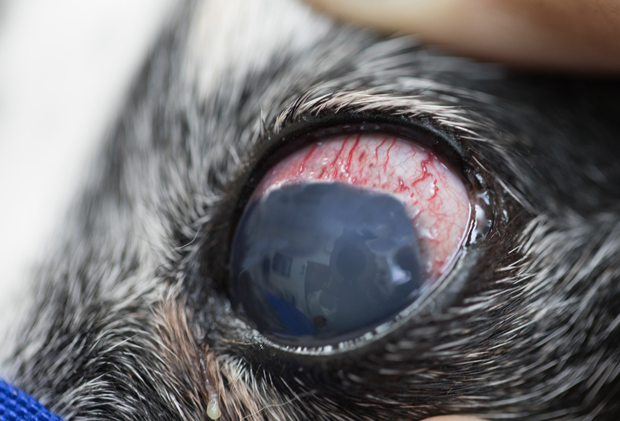By Carl Palazzolo, DVM, Long Beach Animal Hospital (LBAH)
Photos courtesy of LBAH
Glaucoma is a disease in which the normal fluid in the eye does not drain properly. This causes pressure buildup, significant pain and possible loss of vision if not diagnosed and treated early in the course of the disease.
The fluid in the eye is called aqueous humor. It is produced by the ciliary body within the eye and drains through a channel between the cornea and the iris. This normal production and drainage are in equilibrium, maintaining a normal pressure within the eye. This is known medically as intraocular pressure. This gives the eye its shape and nourishes the eye with oxygen and nutrition so that all of the internal organs can function properly.
Glaucoma can be a primary problem that can occur in several breeds of dogs because of improper drainage. Some of these breeds include cocker spaniels, bassetts, Samoyeds, poodles, chows, Jack Russell terriers, shar-peis, shih tzus and huskies. Glaucoma is rare in cats.
Glaucoma can also be secondary to problems within the eye. These include an inflammation called uveitis, bleeding within the eye, severe cataracts, cancer and dislocation of the lens.
Symptoms of glaucoma in a dog may escape notice by the owner. The primary symptom is pain, which in the early stages is easily masked. As the pain advances, your dog might become less active and eat less, which are also the symptoms of many other problems in animals. Your pet can go blind in the bad eye, but because the other eye compensates, you might not be able to spot the blindness.

The redness in this eye is advanced, and in this dog’s case, the glaucoma has resulted in blindness.

For comparison, this is the same dog’s normal eye.
Any time your pet has any symptoms of eye disease, it should be examined by a vet. Such symptoms include redness to the eye, reluctance to be petted on one side of the head, cloudiness in the eye, pawing at the eye, a dilated or a constricted pupil, squinting, discharge or bulging of the eye. When examined by a vet, he or she will check for glaucoma, particularly in older dogs or those with recurring symptoms.
Glaucoma is diagnosed by checking the pressure within the eye. There are various methods to do this. An accurate and common one is with the use of a computerized tonometer. After putting a drop of local anesthetic into the eye, the instrument is gently applied to the cornea to measure the pressure.

An LBAH veterinarian checks the pressures within the eye of an affected dog with a computerized tonometer.

One of the treatments for advanced glaucoma on a painful eye with no vision is to use a version of cryotherapy to stop the ciliary body from producing excess fluid. -80 degrees centigrade is – 112 degrees fahrenheit!
Glaucoma is usually treated by a veterinary ophthalmologist. This is a serious disease and needs the expertise and equipment that only an animal eye specialist has in most cases. Therapy might be medical or surgical, with various surgical procedures performed. Many factors go into deciding which therapy is best. Unfortunately, many glaucoma cases are diagnosed when the disease process is advanced, the eye is non-functional, and the main goal of therapy is to minimize pain.

